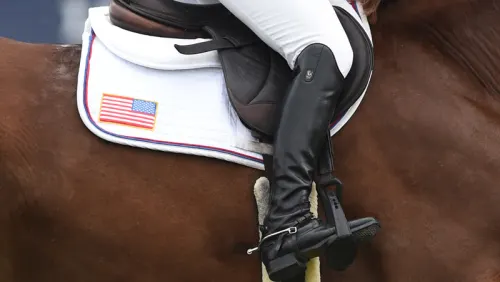People are often taught “safety first,” but why isn’t this mentality applied in lower-level jumper classes? As a professional in this industry, it is my due diligence to call attention to the dangers of speed classes in these jumper divisions. Too often, I’ve stood at the in-gate with students watching, while another rider careens around a 1.0-meter course at a life-threatening pace. These riders leave two strides out of lines, whip around corners, and hope that the small height will mitigate the danger of their treacherous speeds. No blue ribbon is worth putting your neck—or your horse’s—on the line.
The last two horse shows I’ve been to have seen at least two people medevaced out within a 48-hour period in the same low child/adult division. This requires serious conversation on safety issues. These divisions incentivize high speeds over low jumps, which barely serve as speed bumps. The result is serious injuries.
While lower classes are wonderful opportunities to practice in a jumper arena at comfortable heights for the progressing equestrian, it becomes hazardous when riders, in order to win, race through jumps at breakneck speeds. What trainer or parent would feel comfortable pushing their student or child into a dangerous position to get a blue ribbon? How is this allowed?
These injuries could be easily prevented! In order to teach proper riding and the safe practice of the sport, classes under 1.10-meters should be judged on optimum time, not speed. By doing so riders would try to finish their courses as close to the suggested time as possible, still allowing for placement from first through sixth, with a champion being awarded. We should write rules to require that the rider needs a specific number of clear jumping rounds to advance to a higher jumping level. Until these simple rule changes occur, the industry allows students to compete in a dangerous environment, not only permitting precarious events but making them inevitable.

Kama Godek (third from left) wants the rules for lower-level jumper classes to be changed to help ensure rider and horse safety. Photo Courtesy Of Kama Godek
For example, in our young horse classes, the 5-year-old jumper classes are not judged on speed; they’re placed on optimum time because we understand that introducing speed early in a young horse’s career can ruin them. We also need this mentality for riders jumping at 1.10-meter and below, as speed does not work with a developing rider either.
ADVERTISEMENT
Parents and riders need to understand this. Trainers are pressured, at the risk of losing riders, if they stop them from dangerously moving up levels. I’m afraid if I tell my clients no, that they will continue to look for a trainer that will say yes because someone eventually will. Professionals know the risk associated with going quick over low fences, yet parents question our judgment with disregard for safety.
We owe it to our horses and our students to keep them safe. These lower jumper classes need to have obligatory optimum time and clear round rules on jumps below 1.10-meters in order to ensure the welfare of our horses and riders.
Kama Godek is a professional rider and trainer who has competed up to the CSI5* level. Godek worked for Laura Kraut and Katie Prudent before spending over a decade riding and teaching in Europe, where she got her German Trainers certification from the Westphalian Rider and Driving School in Münster, Germany. Godek currently runs a training and sales business in Aldie, Virginia.














